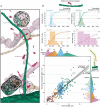This is a preprint.
Nanometer-scale views of visual cortex reveal anatomical features of primary cilia poised to detect synaptic spillover
- PMID: 37961618
- PMCID: PMC10635062
- DOI: 10.1101/2023.10.31.564838
Nanometer-scale views of visual cortex reveal anatomical features of primary cilia poised to detect synaptic spillover
Update in
-
Ultrastructural differences impact cilia shape and external exposure across cell classes in the visual cortex.Curr Biol. 2024 Jun 3;34(11):2418-2433.e4. doi: 10.1016/j.cub.2024.04.043. Epub 2024 May 14. Curr Biol. 2024. PMID: 38749425 Free PMC article.
Abstract
A primary cilium is a thin membrane-bound extension off a cell surface that contains receptors for perceiving and transmitting signals that modulate cell state and activity. While many cell types have a primary cilium, little is known about primary cilia in the brain, where they are less accessible than cilia on cultured cells or epithelial tissues and protrude from cell bodies into a deep, dense network of glial and neuronal processes. Here, we investigated cilia frequency, internal structure, shape, and position in large, high-resolution transmission electron microscopy volumes of mouse primary visual cortex. Cilia extended from the cell bodies of nearly all excitatory and inhibitory neurons, astrocytes, and oligodendrocyte precursor cells (OPCs), but were absent from oligodendrocytes and microglia. Structural comparisons revealed that the membrane structure at the base of the cilium and the microtubule organization differed between neurons and glia. OPC cilia were distinct in that they were the shortest and contained pervasive internal vesicles only occasionally observed in neuron and astrocyte cilia. Investigating cilia-proximal features revealed that many cilia were directly adjacent to synapses, suggesting cilia are well poised to encounter locally released signaling molecules. Cilia proximity to synapses was random, not enriched, in the synapse-rich neuropil. The internal anatomy, including microtubule changes and centriole location, defined key structural features including cilium placement and shape. Together, the anatomical insights both within and around neuron and glia cilia provide new insights into cilia formation and function across cell types in the brain.
Keywords: Cilia; astrocyte; axoneme; centrosome; ciliary pocket; electron microscopy; neuronal cilia; oligodendrocyte precursor cell; transition zone.
Figures








References
-
- Aten S., Kiyoshi C.M., Arzola E.P., Patterson J.A., Taylor A.T., Du Y., Guiher A.M., Philip M., Camacho E.G., Mediratta D., Collins K., Boni K., Garcia S.A., Kumar R., Drake A.N., Hegazi A., Trank L., Benson E., Kidd G., Terman D., and Zhou M.. 2022. Ultrastructural view of astrocyte arborization, astrocyte-astrocyte and astrocyte-synapse contacts, intracellular vesicle-like structures, and mitochondrial network. Prog Neurobiol. 213:102264. doi:10.1016/j.pneurobio.2022.102264. - DOI - PMC - PubMed
-
- Banks G., Lassi G., Hoerder-Suabedissen A., Tinarelli F., Simon M.M., Wilcox A., Lau P., Lawson T.N., Johnson S., Rutman A., Sweeting M., Chesham J.E., Barnard A.R., Horner N., Westerberg H., Smith L.B., Molnár Z., Hastings M.H., Hirst R.A., Tucci V., and Nolan P.M.. 2017. A missense mutation in Katnal1 underlies behavioural, neurological and ciliary anomalies. Mol Psychiatr. 23:713–722. doi:10.1038/mp.2017.54. - DOI - PMC - PubMed
Publication types
Grants and funding
LinkOut - more resources
Full Text Sources
